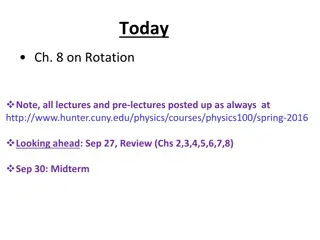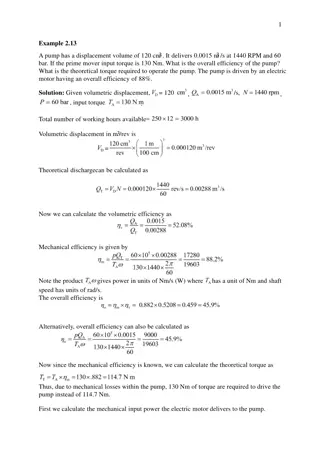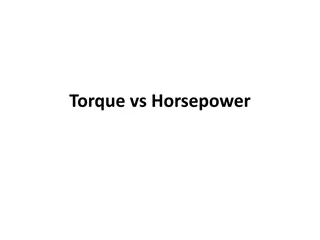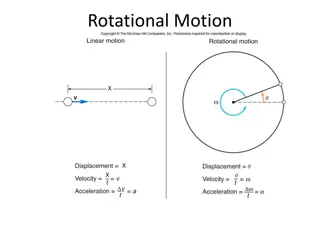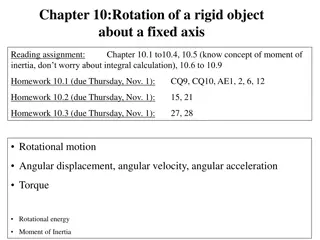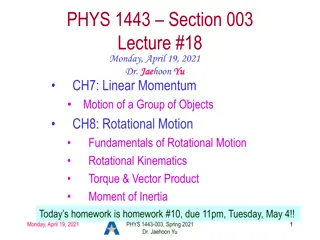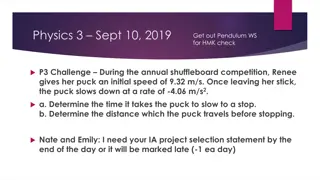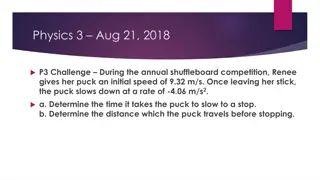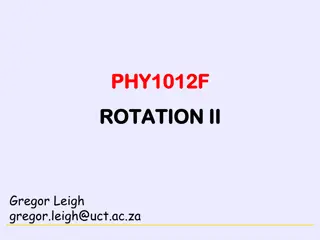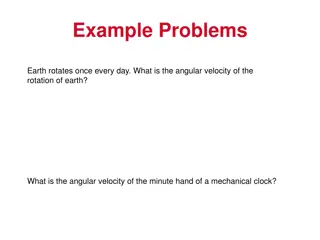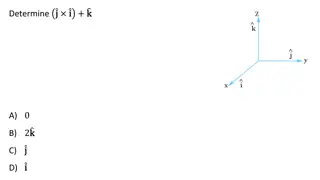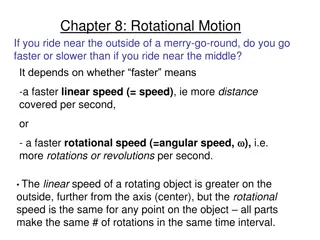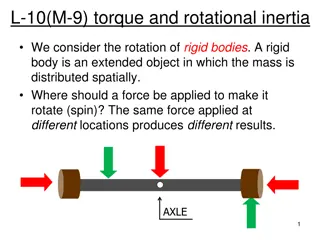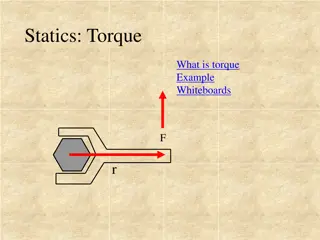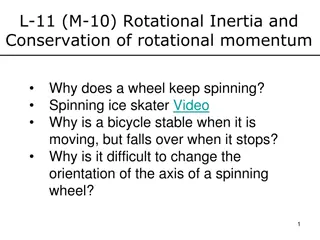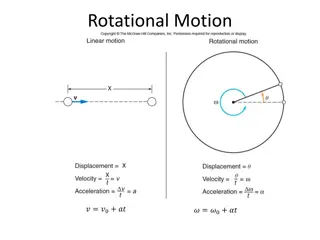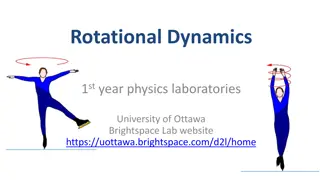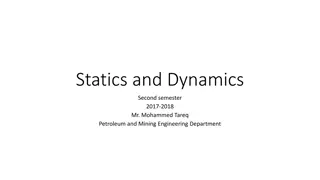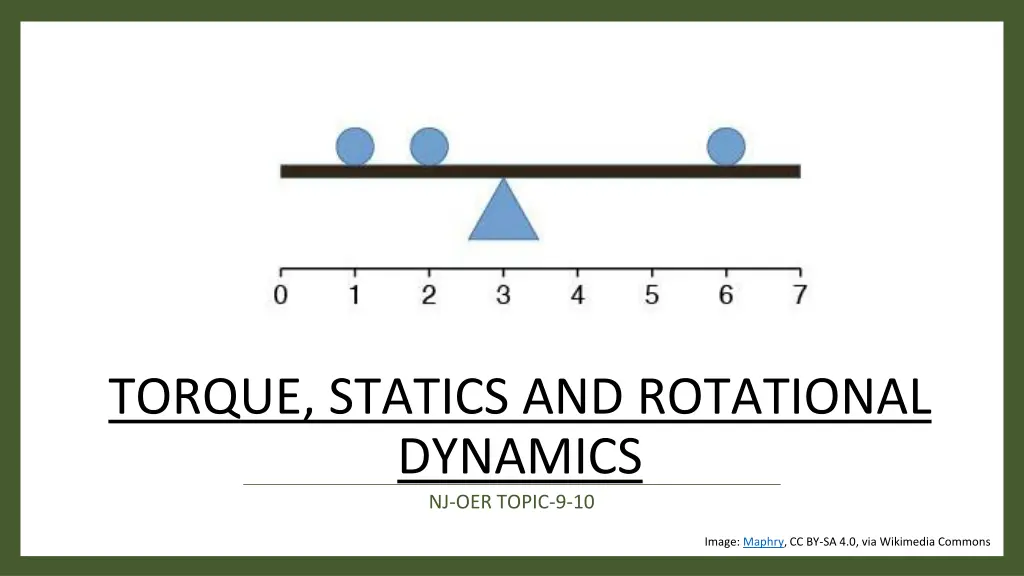
Understanding Torque, Statics, and Rotational Dynamics in Physics
Delve into the concepts of torque, statics, and rotational dynamics in physics, covering equilibrium conditions, net torque calculations, rotational kinetic energy, conservation laws, and more. Explore the analogies between force and torque, mass and moment of inertia, and linear and angular accelerations for a comprehensive understanding. Learn about the SI units associated with these concepts and deepen your knowledge of rotational motion.
Download Presentation

Please find below an Image/Link to download the presentation.
The content on the website is provided AS IS for your information and personal use only. It may not be sold, licensed, or shared on other websites without obtaining consent from the author. If you encounter any issues during the download, it is possible that the publisher has removed the file from their server.
You are allowed to download the files provided on this website for personal or commercial use, subject to the condition that they are used lawfully. All files are the property of their respective owners.
The content on the website is provided AS IS for your information and personal use only. It may not be sold, licensed, or shared on other websites without obtaining consent from the author.
E N D
Presentation Transcript
TORQUE, STATICS AND ROTATIONAL DYNAMICS NJ-OER TOPIC-9-10 Image: Maphry, CC BY-SA 4.0, via Wikimedia Commons
Original Publication Year 2022 General Physics I by Moe Tabanli is licensed under aCreative Commons Attribution-NonCommercial-ShareAlike 4.0 International License, except where otherwise noted. To learn more about the Open Textbook Collaborative, visit https://middlesexcc.libguides.com/OTCProject Under this license, any user of this textbook or the textbook contents herein must provide proper attribution as follows: If you redistribute this textbook in a digital or print format (including but not limited to PDF and HTML), then you must retain this attribution statement on your licensing page. If you redistribute part of this textbook, then you must include citation information including the link to the original document and original license on your licensing page. If you use this textbook as a bibliographic reference, please include the link to this work https://opennj.net//physics- tabanli in your citation. For questions regarding this licensing, please contact library@middlesexcc.edu Funding Statement This material was funded by the Fund for the Improvement of Postsecondary Education (FIPSE) of the U.S. Department of Education for the Open Textbooks Pilot grant awarded to Middlesex College (Edison, NJ) for the Open Textbook Collaborative. Open Textbook Collaborative The Open Textbook Collaborative. (OTC) project is a statewide project managed by Middlesex College along with assistance from Brookdale Community College, Ocean County College , Passaic County Community College, and Rowan University . The project engages a consortium of New Jersey community colleges and Rowan University to develop open educational resources (OER) in career and technical education STEM courses. The coursesalign tocareer pathways in New Jersey s growth industries including health services, technology, energy, and global manufacturing and supply chain management as identified by the New Jersey Council of Community Colleges.
State the first condition of equilibrium. State the second condition of equilibrium. Calculate net torque from force, distance and angle Study the turning effect of force. Study the analogy between force and torque, mass and moment of inertia, and linear acceleration and angular acceleration. Calculate rotational kinetic energy. Demonstrate the law of conservation of energy. Calculate angular momentum. Demonstrate the law of conservation of angular momentum Learning Outcomes
= Torque magnitude = Torque as a vector. It is negative for clockwise and positive for counterclockwise Torque is always defined in terms of a rotation with respect to a point. I = Moment of Inertia M= Mass R=Radius = Angular acceleration = Angular velocity L = Angular momentum KEr= Rotational energy KET= Translational energy mi= mass of each object Concepts ?net= Net torque. This is the vector sum of all torque F = magnitude of Force r="Distance of the force to the point of rotation" ?=angle between the force and the line joining point of application to point of rotation
SI UNITS Torque is in N.m Angular velocity and angular speed is in rad/s Angular acceleration is in rad/s2 Moment of inertia is in kg m2 Energy or work is in Joule J Angular momentum is in kg m2/ s Units
?= ?????? ?= ? F ? =????? perpendicular distance ?= ?F F =F???? perpendicular component I = m ?2 ?=?? ?=??/?? Li= Lf Li= Lf if (external) = 0 Formulas and Constants For multiple forces net= (+/-) Forces that rotates counterclockwise are - Forces that rotates clockwise are + ?= net ? KET= mv2 KET= I ?2 ? =v/R for rolling E=KET+KEr+PE Ef=Ei if WNC=0 ?net= I ? acceleration ?net = 0 (equilibrium)
KEY STRATEGIES TO FIND NET TORQUE There are 3 identical equations. Based on the problem, one of them might be more convenient Draw the free body diagram TORQUE DEPENDS ON THE POINT OF ROTATION Identify the distances Identify the angles Identify the sign of Torque by asking which way would it rotate if it was the only force ?= ?????? ?= ? F ? =????? perpendicular distance ?= ?F F =F???? perpendicular component These are magnitude equations Signs are determined by the direction of rotation Calculate individual torques and add
FINDING TORQUE USING FREE BODY DIAGRAMS Figure 3 Figure 2 Figure 1 Torque is the rotational effect of force. If a force can't rotate, its torque is zero. Net torque is the vector sum of all torques Figure 4 Figures 1, 3, 4: CC by Texas Education Agency (TEA) is licensed under Creative Commons Attribution License v4.0 Figure 2: Lead holder, CC BY-SA 4.0, via Wikimedia Commons
NET TORQUE CLASSWORK A metal bar with 6 meters length is placed on the x-axis horizontally. Three forces are acting on it. F1=4N is applied upward 2 meters from the left edge, F2=6N is applied making 30 degrees with the x-axis from 4 meters distance from the left edge and F3=20N is applied towards right from the right edge. Find net if a) There is a pin on the left edge b) There is a pin at the center c) There is a pin at the right edge. F1 F2 F3 F1 r1 Torque1 F2 r2 Torque2 F3 r3 Torque3 net 4 6 20 Rotate from the left Rotate from the center Rotate from the right 4 6 20 4 6 29 |?|= ?????? however r changes for each case. r is the distance from the point of rotation to the point of application Sign for individual torques Torque1 Torque2 Torque3 may also change depending on the point of rotation. Image: CC by M.Tabanli and J. Meenu
CLASSWORK ON TORQUE EQUILIBRIUM FIND THE MISSING FORCE 1) A uniform 1000-N piece of metal that is 12 m long is suspended horizontally by two vertical wires. One wire is at the left end and the other one is 9 meters away from the left end. What are the tensions 2) A uniform meter stick with 4 N weight is held in equilibrium by two supports. First string is at 20 cm mark and the other is at 60 cm mark. What are the normal forces on the supports? 4) A 2kg metal bar is attached to a wall, free to rotate about the pivot. Metal bar is 3 meters long. On the other end, the bar is attached to a cable that makes 24 degrees angle with the horizontal. Calculate the tension in the cable. Calculate x and y components of the reaction force that the pivot is exerting (Rx, Ry) using the first condition of equilibrium. ?= ?????? Fnet=0 ?net=0 Simulation by PhET Interactive Simulations, University of Colorado Boulder, licensed under CC-BY-4.0 (https://phet.colorado.edu).
ACTIVITY ON EQUILIBRIUM: Simple Machines Go to https://phet.colorado.edu/sims/html/balancing-act/latest/balancing-act_en.html Go to balancing LAB. Click on ruler. Place a M1=5 gr load at 1.5 meters distance. Balance M1 load with a M2 load. Remove the supports. At equilibrium, mark the distance of F2 from the point of rotation. Write the value on the table below. Change M2 repeat for 3 more times Calculate each force using F = mg . g is gravity. Write the simple machine equation F1 X L1 = F2 X L2 Verify that Torque left is equal to Torque right. This is a magnitude equation. Find the reaction force R exerted by the support point using Newton s Law for equilibrium. ?(left)Nm ?(right) Nm M1 (gr) F1 (N) L1 (m) M2 (gr) F2(N) L2 (m) R(N) 5 1.5 5 5 1.5 10 5 1.5 15 5 1.5 30 Simulation by PhET Interactive Simulations, University of Colorado Boulder, licensed under CC-BY-4.0 (https://phet.colorado.edu).
ADVANCED ACTIVITY ON NET TORQUE Open https://phet.colorado.edu/sims/html/balancing-act/latest/balancing-act_en.html Go to balancing lab, click on the ruler. Attach a M1=15 gr load 1 meter away from the point of rotation Balance M1 load with two masses M2 and M3, mark their location from the point of rotation. Write the value on the table below. Repeat for 3 more times using the values on the table. Calculate each force using F = mg and calculate Torque for each force. Determine the signs for each torque Add the Torques and verify that net torque is equal to zero at equilibrium. ?1(Nm) ?2(Nm) ?3(Nm) ?net(Nm) m1(gr) F1(N) r1(m) m2(gr) F2(N) r2(m) m3(gr) F3(gr) r3(m) 10 1 5 5 10 1 5 10 10 1 5 15 10 1 5 20 = Fr since the weight is perpendicular, sin?=1 net= (+/-) Forces that rotates counterclockwise are - Forces that rotates clockwise are + Simulation by PhET Interactive Simulations, University of Colorado Boulder, licensed under CC-BY-4.0 (https://phet.colorado.edu).
CLASSWORK ON MOMENT OF INERTIA Moment of inertia is the mass equivalent for rotational systems 1) Calculate the moment of inertia of a 5 kg sphere with 0.4 meters radius 2) What should be the mass of a thin spherical shell of radius 0.2 meters so that its moment of inertia is 20 kgm2. 3) A solid cylinder of mass 16kg and radius 0.5 m is rotated about the central diameter. What is the length of the cylinder so that its moment of is 2.4 kgm2. 4) An annular cylinder with 4kg mass, 0.6 m outer radius and 0.4 meters inner radius is rotated about its center. What is its moment of inertia 5) A disc with I1=4kgm2is placed on top of a slab with I2=7kgm2. What is the total moment of inertia. Image: CC by Texas Education Agency (TEA) is licensed under Creative Commons Attribution License v4.0
ROTATIONAL EQUIVALANTS OF TRANSLATIONAL CONCEPTS AND EQUATIONS inertia motion acceleration momentum kinetic energy action KE= mv2 Translational m v a P=mv Force KEr= I 2 ? Rotational I L=I Torque Equilibrium Statics Dynamics Conservation of Momentum Conservation Of Energy Translational Fnet=0 F=ma Pi = Pf KEi+PEi=KEf+PEf ?net=0 ?=I? Rotational Li = Lf KEi+KERi+PEi=KEf+KERf+PEf
CLASSWORK RELATED TO DYNAMIC SYSTEMS 1)A girl and a boy push a merry go round initially at rest. The boy applies 20 N force from 1.0 m away from the center tangentially and the girl applies 40 N from 0.9 m away from the center tangentially both rotating clockwise. Merry go round is a solid disc of radius 1.0 m and with mass m=80kg. Calculate (Find I and torquenet ) 2) Two opposing forces acting on disc with 0.5m radius and I=4kgm2. Disc is free to rotate about its center. First force is 30 N counterclockwise acting with 30 degrees angle relative to the radial direction and the other one is 20N clockwise acting with 45 degrees from the edge of the disc. Calculate its angular acceleration. 3) A 5.0 kg solid spherical ball with 0.2m radius is rolling without slipping with v=4.1 m/s. It climbs up a ramp. Calculate the maximum height it can reach before coming to stop. I=2/5 MR2?=V/R. Energy is conserved. 4) A solid disc of mass 2.0 kg and radius 0. 20 m rolls down from 2.5 meters height on an inclined plane. Its velocity at the end of the ramp is 5.3 m/s. How much energy is lost to friction? ( I= M R2g= 9.80 m/s2.) 5) A solid disc with moment of inertia I = 20 kg.m2is rotating with angular velocity = 6rad/s . A smaller disc at rest with I= 10 kg.m2is dropped on the larger disc. What is the final angular velocity of the system? (Li=Lf) 6) A skater has a moment of inertia of 5.0 kg m2when her arms are open, and at this time she is spinning at 0.90 rad/s. When she pulls in her arms in and her moment of inertia decreases to 4.5 kg m2, how fast will she be spinning?
REFERENCES Slide 1: Maphry, CC BY-SA 4.0, via Wikimedia Commons Slide 7 Middle image: Lead holder, CC BY-SA 4.0, via Wikimedia Commons Slide 7 Left and right images: Open Stax College Physics online textbook Slide 9: Gen-Ed-Phys-I Workbook by M.Tabanli and J. Meenu Slide 10-11 Screenshots from PhET Interactive Simulations University of Colorado Boulder https://phet.colorado.edu Slide 12: Open Stax College Physics online textbook


